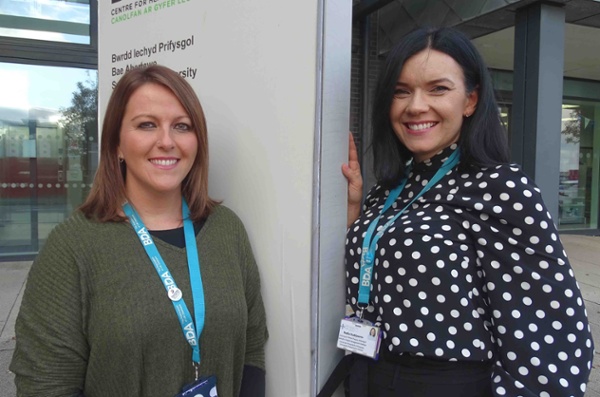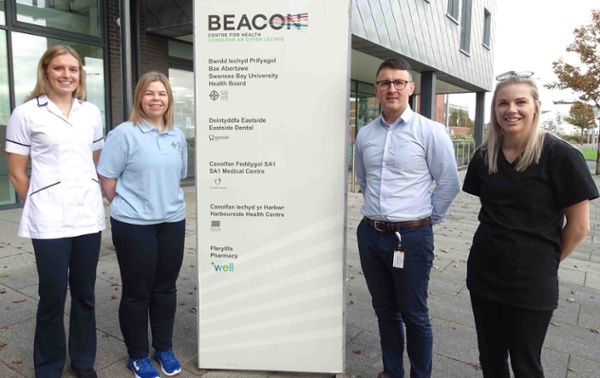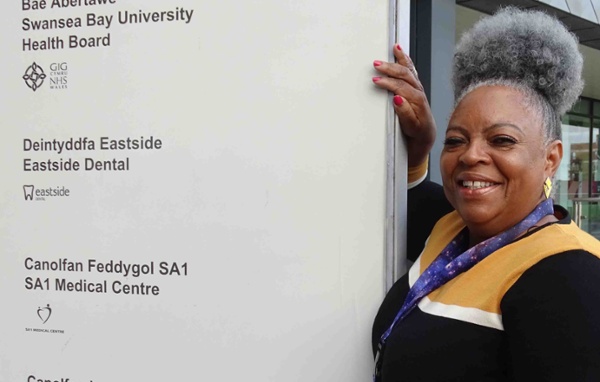New team keeps patients in the best possible shape while they await surgery

People waiting for new hips or knees are being offered extra support to keep them in the best possible shape until their surgery can go ahead.
More than 2,000 of them across Swansea Bay have been invited to an assessment to see what options could be available to them.
These range from weight management and exercise classes, physiotherapy, steroid injections for pain management, or mobility aids such as walking sticks or knee braces.
Pictured above - the orthopaedic prehabilitation team. See end of release for full caption.
Although only recently launched, the health board’s orthopaedic Prehabilitation service has already assessed almost 150 patients. Of these, around 100 have been referred on to one or more of the various treatments on offer, with virtual options available too.
As is the case across Wales, waiting lists for hip and knee replacements have been high in Swansea Bay for some time, a situation which the pandemic exacerbated.

The health board is working hard to address this, including opening new theatres at Neath Port Talbot Hospital which is being developed as a centre of excellence for planned orthopaedic and spinal surgery.
Dietetic assistant practitioner Rhiannon Rogers (left) and senior dietitian Nadia Kudrjasova
But the longer people wait, the greater the risk their mobility and therefore their quality of life will deteriorate. For some it could lead to weight gain, which in turn could affect their fitness for surgery, or even delay it.
The new prehab service is being funded by the Welsh Government as part of its 3Ps (promote, prevent and prepare for planned care) policy.
Service clinical lead Chris Lambert said invitations for an initial assessment had been sent out to all patients in Swansea Bay awaiting replacement knees or hips – around 2,200 of them.
“They can come into an assessment clinic where they are given treatment options by a senior physiotherapist or senior dietitian depending on their needs and preferences,” said Chris, an advanced practice physiotherapist.
“Treatment is not compulsory, and some patients choose self-management options instead.
“The idea is to support them on the waiting list to try to optimize the patient’s pre-surgery health status. This in turn should improve the outcome from surgery and speed up their post operation recovery.
“Being fitter before the surgery may help them to recover quicker after their operation.”
One of the options is a weight management programme for people whose Body Mass Index, or BMI, is high. Because of the increased anaesthetic risks for these patients, the likelihood is that their surgery will be deferred.
Specialist weight management dietitian Nadia Kudrjasova and dietetic assistant practitioner Rhiannon Rogers are there to help.

Nadia said: “Losing weight can be challenging for many reasons. Some people may not be as active as they once were due to joint pain and reduced mobility, or their eating habits might have altered.
“We will be providing tailored support for patients based on their individual needs.”
Right: The physiotherapy team (l-r) Natalie Capel, Natalie McCarthy, Chris Lambert and Alice Mayo
After the initial assessment, patients will be offered to attend a weight management group programme with Rhiannon, or one-to-one appointments with Nadia.
The group classes consist of 12 weekly sessions. They include everything from weight management and healthy eating for osteoarthritis to overcoming emotional eating and changing eating habits for good. Practical cookery sessions are also being planned.
As well as the dietitians, there will also be physiotherapy-based options which extend beyond a simple exercise regime.
Physiotherapist Alice Mayo said: “We assess them in clinic and then there are three tiers to it.
“We have hydrotherapy, we have exercise groups within physiotherapy, in the gyms. We can also refer to the patient’s local leisure centre for community-based exercise delivered by our National Exercise Referral Scheme colleagues.
“Alongside this we can offer knee braces and steroid injections. We have the option of doing community visits, visiting people in their own homes, and offering walking aids.”
 People are not necessarily limited to one option. Some, for example, might be referred to a combined weight management and exercise group. There are virtual options, too, for those unable to attend in person.
People are not necessarily limited to one option. Some, for example, might be referred to a combined weight management and exercise group. There are virtual options, too, for those unable to attend in person.
Chris said the overall aim was to try to prevent the deterioration that could be a consequence of being on an extended waiting list.
“We are trying to prevent or limit the deterioration of health and functional status that happens to patients typically whilst they wait on extended waiting lists for surgery,” he added.
Left: Booking coordinator Lorraine Mthembu
“We support them to maintain and improve their mobility while they wait. We keep them as active as possible and change their outlook from waiting for surgery to actively preparing for it.
“We are trying to optimize their function at home through weight loss, exercise, pain management, and through practical support such as walking aids, to try to reduce that decline while they wait for surgery.”
Main photo shows (l-r): physiotherapy assistant Emma Stephens; booking coordinator Lorraine Mthembu; senior physiotherapist Alice Mayo; clinical lead and advanced practice physiotherapist Chris Lambert; senior dietitian Nadia Kudrjasova; dietetic assistant practitioner Rhiannon Rogers; physiotherapist Natalie Capel; physiotherapy assistant Natalie McCarthy. Completing the team, but not in the photo, is business support manager Lowri Ridings.
Rydym yn croesawu gohebiaeth a galwadau ffôn yn y Gymraeg neu'r Saesneg. Atebir gohebiaeth Gymraeg yn y Gymraeg, ac ni fydd hyn yn arwain at oedi. Mae’r dudalen hon ar gael yn Gymraeg drwy bwyso’r botwm ar y dde ar frig y dudalen.
We welcome correspondence and telephone calls in Welsh or English. Welsh language correspondence will be replied to in Welsh, and this will not lead to a delay. This page is available in Welsh by clicking ‘Cymraeg’ at the top right of this page.